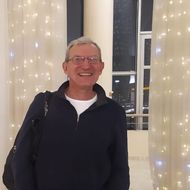Physicists from Russia and Brazil Unveil Mystery behind Complex Superconductor Patterns

The mechanism is described by the Ginzburg–Landau equation at the Bogomolny point
Scientists at HSE MIEM and MIPT have demonstrated that highly complex spatial structures, similar to the intricate patterns found in nature, can emerge in superconductors. Mathematically, these patterns are described using the Ginzburg–Landau equation at a specific combination of parameters known as the Bogomolny point. The paper has been published in the Journal of Physics: Condensed Matter.
One of the most intriguing and not fully understood questions in science is how seemingly simple natural laws give rise to complex patterns, such as zebra stripes or fish scales.
Scientists have long been trying to understand how such patterns emerge in nature. The first explanation was offered in 1952 by mathematician Alan Turing, one of the founders of computer science. According to Turing, complex patterns arise from the competition between simple interactions within a system. Thus, in chemical reactions, patterns are formed through two main mechanisms: diffusion (the distribution of substances) and autocatalysis (where the reaction accelerates itself). It soon became clear that while the Turing model can also describe the emergence of complex patterns in biology effectively, it does not account for all natural phenomena.
Scientists at HSE and MIPT, in collaboration with physicists at Universidade Federal de Pernambuco, Brazil, found that the formation of complex patterns in nature can also be explained using the Ginzburg–Landau equation that describes how the state of a superconductor changes in response to a magnetic field.
A superconductor is a material that conducts electric current without resistance, meaning there is no loss of electricity. Under the influence of a magnetic field, superconductors can exhibit different behaviours: they can either completely expel the magnetic field or allow it to penetrate their mass, forming spatial structures such as a lattice of vortices.
However, according to the theory of superconductivity, there exists a special combination of superconductor parameters—referred to as the Bogomolny point—where any structure can emerge. In this study, the scientists investigated how a magnetic field changes in response to external conditions near the Bogomolny point.

Co-author of the paper, Professor, MIEM HSE
An infinite variety of intricate configurations, like monsters, lie dormant at the Bogomolny point, waiting to be unleashed as you move away from it. Depending on how you move away from it, certain types of configurations emerge. There are various methods to move away: altering the temperature, adjusting the sample size, initiating an electric current, or stacking two superconductors atop each other. This will produce a vast array of exotic patterns.
For example, structures emerge in superconductors where regions devoid of a magnetic field coexist with regions where the magnetic field forms lattices of vortices. A superconducting film can give rise to extremely exotic patterns resembling the distribution of cases in the COVID-19 pandemic.
Co-author of the paper, Professor, MIEM HSE
Previously, superconductivity was not considered a phenomenon where complex patterns could occur, as a superconductor is a relatively simple physical system. However, it turns out that highly complex magnetic structures can indeed manifest in superconductors. Our research contributes to the current understanding of how complex patterns emerge in seemingly simple systems.
The scientists suggest that the effects observed in superconductors could be used in the development of measuring instruments. For instance, by monitoring changes in configurations within a superconductor, one can gauge the extent of temperature, current, or geometric alterations in the sample.
Vasily Stolyarov
Co-author of the paper, Director, Centre for Advanced Mesoscience and Nanotechnology, MIPT
Research in this field has been ongoing from both theoretical and experimental perspectives, as well as from a technological standpoint. Since 2018, we have been the pioneers in conducting and publishing a series of experimental studies that led to the discovery and description of the process of pattern formation on the mesoscopic scale in ferromagnetic superconductors. Now, we are actively searching for and devising new systems where superconducting patterns can be controlled, thus enabling their application in nanotechnology and nanodevices.
See also:
New Method for Describing Graphene Simplifies Analysis of Nanomaterials
An international team, including scientists from HSE University, has proposed a new mathematical method to analyse the structure of graphene. The scientists demonstrated that the characteristics of a graphene lattice can be represented using a three-step random walk model of a particle. This approach allows the lattice to be described more quickly and without cumbersome calculations. The study has been published in Journal of Physics A: Mathematical and Theoretical.
Scientists Have Modelled Supercapacitor Operation at Molecular and Ionic Level
HSE scientists used supercomputer simulations to study the behaviour of ions and water molecules inside the nanopores of a supercapacitor. The results showed that even a very small amount of water alters the charge distribution inside the nanopores and influences the device’s energy storage capacity. This approach makes it possible to predict how supercapacitors behave under different electrolyte compositions and humidity conditions. The paper has been published in Electrochimica Acta. The study was supported by a grant from the Russian Science Foundation (RSF).
Designing an Accurate Reading Skills Test: Why Parallel Texts are Important in Dyslexia Diagnosis
Researchers from the HSE Centre for Language and Brain have developed a tool for accurately assessing reading skills in adults with reading impairments. It can be used, for instance, before and after sessions with a language therapist. The tool includes two texts that differ in content but are equal in complexity: participants were observed to read them at the same speed, make a similar number of errors, and understand the content to the same degree. Such parallel texts will enable more accurate diagnosis of dyslexia and better monitoring of the effectiveness of interventions aimed at addressing it. The paper has been published in Educational Studies.
Internal Clock: How Heart Rate and Emotions Shape Our Perception of Time
Our perception of time depends on heart rate—this is the conclusion reached by neuroscientists at HSE University. In their experiment, volunteers watched short videos designed to evoke specific emotions and estimated each video's duration, while researchers recorded their heart activity using ECG. The study found that the slower a participant's heart rate, the shorter they perceived the video to be—especially when watching unpleasant content. The study has been published in Frontiers in Psychology.
‘It Was Interesting to See How Our Chinese Colleagues Work’: HSE Researchers Take Part in Hefei Summer School
This summer, Diana Sukhoverkhova, Daria Mazur, and David Kagramanyan, research assistants at the MIEM HSE Laboratory for Computational Physics, spent five weeks in China. At the Future Scientist Exchange Program (FuSEP) summer school in Hefei, they worked in new fields of science together with their Chinese colleagues. HSE's promising scientists spoke to the HSE News Service about their intense and productive time in China.
Scientists Identify Personality Traits That Help Schoolchildren Succeed Academically
Economists from HSE University and the Southern Federal University have found that personality traits such as conscientiousness and open-mindedness help schoolchildren improve their academic performance. The study, conducted across seven countries, was the first large-scale international analysis of the impact of character traits on the academic achievement of 10 and 15-year-olds. The findings have been published in the International Journal of Educational Research.
HSE Scientists Reveal How Disrupted Brain Connectivity Affects Cognitive and Social Behaviour in Children with Autism
An international team of scientists, including researchers from the HSE Centre for Language and Brain, has for the first time studied the connectivity between the brain's sensorimotor and cognitive control networks in children with autism. Using fMRI data, the researchers found that connections within the cognitive control network (responsible for attention and inhibitory control) are weakened, while connections between this network and the sensorimotor network (responsible for movement and sensory processing) are, by contrast, excessively strong. These features manifest as difficulties in social interaction and behavioural regulation in children. The study has been published in Brain Imaging and Behavior.
Similar Comprehension, Different Reading: How Native Language Affects Reading in English as a Second Language
Researchers from the MECO international project, including experts from the HSE Centre for Language and Brain, have developed a tool for analysing data on English text reading by native speakers of more than 19 languages. In a large-scale experiment involving over 1,200 people, researchers recorded participants’ eye movements as they silently read the same English texts and then assessed their level of comprehension. The results showed that even when comprehension levels were the same, the reading process—such as gaze fixations, rereading, and word skipping—varied depending on the reader's native language and their English proficiency. The study has been published in Studies in Second Language Acquisition.
Mortgage and Demography: HSE Scientists Reveal How Mortgage Debt Shapes Family Priorities
Having a mortgage increases the likelihood that a Russian family will plan to have a child within the next three years by 39 percentage points. This is the conclusion of a study by Prof. Elena Vakulenko and doctoral student Rufina Evgrafova from the HSE Faculty of Economic Sciences. The authors emphasise that this effect is most pronounced among women, people under 36, and those without children. The study findings have been published in Voprosy Ekonomiki.
Scientists Discover How Correlated Disorder Boosts Superconductivity
Superconductivity is a unique state of matter in which electric current flows without any energy loss. In materials with defects, it typically emerges at very low temperatures and develops in several stages. An international team of scientists, including physicists from HSE MIEM, has demonstrated that when defects within a material are arranged in a specific pattern rather than randomly, superconductivity can occur at a higher temperature and extend throughout the entire material. This discovery could help develop superconductors that operate without the need for extreme cooling. The study has been published in Physical Review B.


